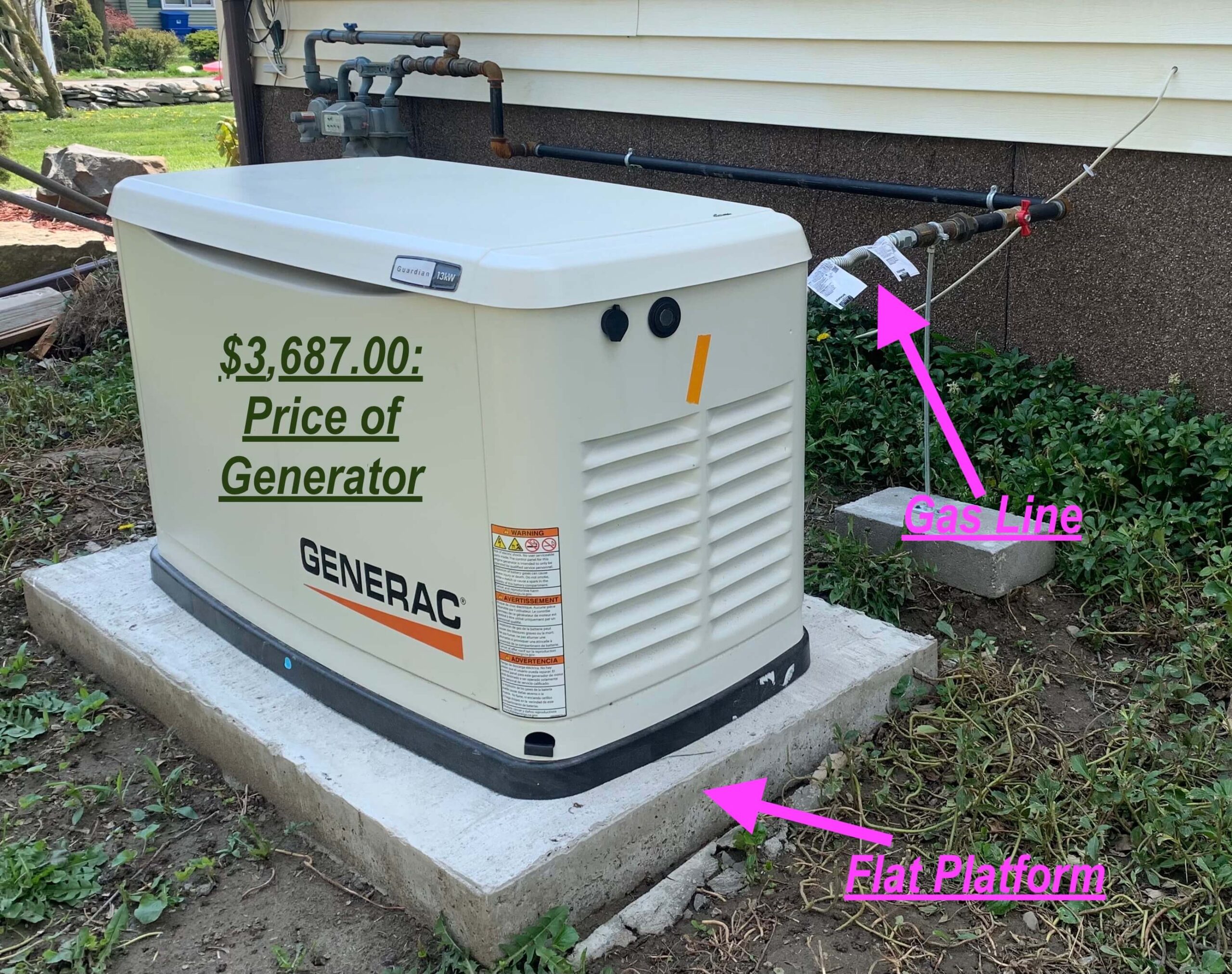Table Of Content

One of the most crucial considerations when choosing a generator is ensuring that the unit will provide sufficient power. Standby generators come in sizes ranging in power from 9 to 48 kilowatts (kW) and cost from $500 to $18,000. One of the best standby generators with about 20 to 24 kW can power most of a home’s appliances and costs $5,000 to $6,500. Another option is the portable generator, which can range in power from about 1 to 7.5 kW.

Whole-House Generator Cost by Type of Fuel
Whole house generators will typically start at 22,000 watts and can run as high as almost 50,000. A whole house generator can provide back-up power for your entire home, including for essential appliances like your air conditioner, sump pump and refrigerator. Property estimated and installed, you should be able to run everything at full capacity, whether you’re going off the grid permanently or you’re forced off temporarily due to an emergency. Repair for smaller standby generators, such as a 10KW generator, costs much less and usually sits around $50. If you are running a commercial-grade generator out of your home, expect to pay as much as $600 for a repair. Portable generators are also cheaper as you don’t need any installation or permits for them.
How do I correctly size a generator for my home?
A whole home generator, by contrast, is a more permanent structure that requires proper setup. Installation costs include labor and electrical work including circuitry and transfer switches. You can often find both portable and whole-house liquid propane generators. Whole-house propane generators usually range from $2,200 to $21,000, while portable options cost between $600 and $2,800. Liquid propane is relatively clean-burning compared to diesel and gas, so it’s an eco-friendly choice. It’s also a popular option for people who live off grid or in rural areas since no gas line is required.
The 5 Best Whole House Generators of 2024
Automatic transfer switches offer effortless power restoration by detecting outages and facilitating a smooth switch to generator power. They’re particularly beneficial for those seeking a hands-off experience. On the other hand, manual transfer switches are more budget-friendly and necessitate manual intervention to redirect power.

Thankfully, there are cheaper alternatives, like portable generators. We will also walk you through the cost factors behind whole house generators and relevant installation costs, so you know how to save safely. With concerns of power outages, a generator has been high on many homeowners’ shopping list.
How Much Do Home Generators Cost and Are They Worth It? - CNET
How Much Do Home Generators Cost and Are They Worth It?.
Posted: Fri, 26 Jan 2024 08:00:00 GMT [source]
How We Chose the Best Home Generators
Should You Buy a Home Generator? - CapeGazette.com
Should You Buy a Home Generator?.
Posted: Sat, 20 Apr 2024 20:58:46 GMT [source]
While it is powerful and built to withstand stormy or freezing conditions, it might be too big for an average-sized home. Large generators are often more expensive and come with high installation costs. 50-amp and 100-amp ATS are generally known as load transfer switches. They switch off the grid power and connect directly to several electrical circuit within the home to power the essential systems, appliances and several lights and outlets.
You won’t find many whole-house gasoline-powered generators, but a portable 5kW gas generator costs around $100 per day to run. Generac generators cost $2,000 to $5,000 for a 7 to 24 kW whole-house unit, plus $3,000 to $5,000 for installation. Generac’s standby generators turn on automatically during power outages and run on natural gas or liquid propane. Portable gasoline generators cost $500 to $2,500 for a 3 to 10 kW backup unit. Whole house generators cost $2,000 to $6,000 a natural gas or liquid propane system, without installation. Gasoline is readily available in most parts of the country, making this a popular choice.
When power outages strike for short periods, a generator can prevent the hassles that often follow, like food spoiling. When outages are longer or the result of extreme weather events, generators can prevent disasters. For instance, certain fuel types are more expensive to run than others, so they can drive up long-term maintenance costs.
Generator Cost by Size
Whole-house generator installation costs are the highest because this type of generator can power an entire home. Costing about $500 to $2,000 on average, they can support one or more important systems such as air conditioning in the event of a power outage. While the best portable generators work for emergency use during storms or time spent in a camper, a whole-house generator is a different kind of appliance. They are able to support major systems such as electrical and HVAC in the event that the home loses power. Since whole-house units are permanent and hardwired to your electrical panel, they require transfer switches to function properly. Home generators have the largest power capacity of any type of non-industrial generator and are usually able to provide power to an entire home.
Whole house generators can run quite loudly (65 decibels on the low end to 69+ on the high end), so it’s important to take that range into consideration when purchasing and placing your generator. Air-cooled generators are usually less efficient, and they tend to have shorter shelf lives when used in whole-house contexts. Liquid-cooled generators tend to work best, particularly if you live in an area that often reaches temperatures of over 100 degrees, because they are much less likely to overheat. When you’ve determined what power level you need from your whole house generator, you should consider whether you want an air-cooled or liquid-cooled system. An air-cooled generator either passively uses the surrounding air to cool the engine or relies on a fan to maintain temperature.
These generators are best for people who don't want to lose power in their homes at all — they will kick on within a matter of seconds. Some can be monitored from your phone and even run self-tests to ensure emergency power is always available. Some whole home generators are portable, so they can be taken on the road to power an off-grid cabin, RV or work site. Portable generators are convenient but often need to be manually started with a pull cord. It runs at 70 dBA, quieter than most portable models but louder than you might want in a small home. Additionally, some customers have reported issues with starting and run time after more than five years of use.
A whole-home generator costs $30 to $170 per day to run all day depending on the size and fuel source. Whole-house 15 to 20 kW standby generators consume 133 to 330 cubic feet of natural gas or 3.16 to 3.45 gallons of liquid propane per hour. Whole home natural gas or liquid propane generators cost $2,000 to $6,000 without installation. This depends on the size of the home, the size of the generator, and the number of items that need to be powered.
If you need to maintain power in your home for medical devices, a mobile monitoring generator will help prepare you. This generator’s noise level is pretty standard for its power capacity, rated at 74 dBA. It isn’t equipped for remote monitoring, but a clear gas gauge is on the side to measure your fuel level. The unit weighs a little over 200 pounds and has sturdy wheels for easy transportation. Portable power stations offer a newer addition to the market and are made possible with the rising affordability of high-capacity batteries.
Portable generators typically run on standard gasoline which is affordable and easy-to-acquire, but hard to store long term. You should expect to pay $1,500 at the least and $7,500 at the most, depending on the type of generator you need and the cost of labor in your area. Be sure to purchase the right type of generator for the fuel you’re looking to use, or check to see if it can be easily converted from one fuel source to the other (most can be).
However, many others also praise its reliability and easy installation. When you lose power, a whole-house generator keeps your home’s systems up and running. Some are permanently installed to power your home in an emergency, while others are portable for off-grid camping and mobile job sites. A typical whole home generator will cost between $1,458 and $8,239 without installation or maintenance. Whole home generators can be purchased from a hardware store or retailer, but they require an electrician or other professional installer.
Most solar and battery storage options cost more, especially for higher capacity, but can operate without fossil fuels. One of the biggest factors in the price of a generator is how much it will have to power, typically measured in kilowatts (kW). According to the United States Energy Information Administration, the average American household uses just short of 900 kWh per month, about 30 kWh per day. Typically, generators with 20 kW of capacity are considered whole-home generators and cost more. If a generator has less than 10 kW of power, it's meant for smaller jobs and will cost less.

No comments:
Post a Comment